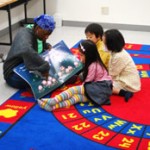We just had a post on 5 Simple Reading Tips, and we received some great comments on that post. We weren’t finished! Here are 5 more tips for you to try.
1) Have a familiar story time routine. A routine is useful for helping students settle down for story time. When students are used to a routine, it is easier for them to focus on and participate in the story. To create a routine, try the following:
a) Play story time music. This works well in classrooms, especially if you play the same music every time. The music is a transition cue to the students, who will quickly learn that the next activity is story time.
b) Have a story time area. Yes, it’s wonderful to be able to plop down almost anywhere and any time to read. But when you have a specific area for story time, you minimize distractions from other parts of the room, and you help students focus better.
2) Have a child help you turn the pages. Children love to help you, and they have likely already noticed that page turning is a big responsibility. Choose a child to come up to you and say, “Mizuki, can you turn the page for me, please?” That child can either remain with you to turn the rest of the pages (choose a different child each storytime), or she can sit down and let another child help with the next page.
3) Make silly mistakes to check comprehension. When you are reading a book to young learners, particularly young learners who are still developing language skills, you may not always know if they are following along with the story. A fun and simple way to make sure students are listening and understanding is to make an occasional playful mistake. For example, if reading The Very Hungry Caterpillar by Eric Carle, instead of reading, “On Thursday, he ate through four strawberries,” point to the strawberries and say, “On Thursday, he ate through four bananas.” If the children are following closely, they will laugh and say, “Nooooo!”, and then point out your mistake to you. Your exchange might go like this:
Teacher: “On Thursday, he ate through four bananas.”
Children: “Noooooo!”
Teacher: “No? What did he eat?”
Children: “Strawberries!”
Teacher: “Ah, yes. Thank you. You’re right! He ate through ten strawberries.”
Children: “Noooo! Not ten. Four!”
Teacher: “Four? Can you count them with me? One, two, three, four! You’re right! He ate through four strawberries. You’re very good readers! Thank you. What do you think he ate next?”
The occasional silly mistake is a great way to get kids involved.
4) Make sound effects to give the story some life. Animal sounds? Make them! Children will be more than willing to help you with animal sounds.
Repeated words or phrases? Invite the children to shout them out at each moment in the story.
Does someone sit down with a thud? Go ahead, say thud or ka-boom when that happens. Does someone start to eat? Add the appropriate slurp slurp slurp for soup, gobble gobble gobble for other foods, and glug glug glug sounds for drinking. The wind goes whooosh and rain goes pitter-patter. The possibilities are endless!
5) Don’t tell, react. Peek at the next page and let your facial expressions give hints about what happens next in the story. But don’t let the children see the next page yet! Wait a moment before continuing. Your facial expressions generate curiosity, and the children will really want to find out what happens next.
For example, when you’re reading Five Little Monkeys, the doctor is increasingly angry from all of those falling monkeys, yes? You can puff your cheeks out and look a little bit angry (not too much…you don’t want to scare the children!). In Goodnight, Gorilla, the zookeeper’s wife turns out the light and then is surprised by the animals who say, “Good night” to her. You can look wide-eyed and surprised.
Ask the children, “What do you think happens next?” Allow them a few seconds to shout out possible answers, then turn the page to see if they were right. It is important here to accept all answers.
What is your favorite Simple Reading Tip?
Happy reading!


